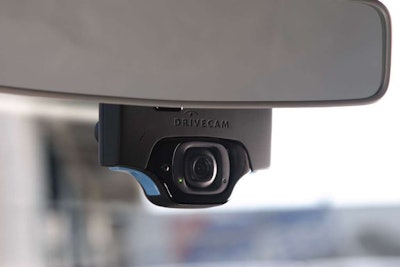 An in-cab camera from DriveCam continuously films the driver and the road, deleting all footage beyond clips that include “trigger events.”
An in-cab camera from DriveCam continuously films the driver and the road, deleting all footage beyond clips that include “trigger events.”One of the biggest concerns fleet managers have is the safety of their drivers and operators and there is no better way to improve the safety of trucks and equipment than technology.
But signing a check for and wiring up a bunch of systems won’t solve your problems if that’s all you do, said presenters at the Association of Equipment Management Professionals annual equipment management conference held last week in Orlando, Florida this year.
Kevin Coppolino, vice president of corporate development at Cellcontrol, and Del Lisk, vice president of safety services for Lytx, both emphasized that the hardware is only part of the solution. The key to lowering accident rates and improving driver behavior is a combination of hardware, training, corporate buy-in, analysis and feedback.
Distracted driving is an epidemic on our highways, said Coppolino. And the numbers are staggering:
- 68 percent of drivers admit they talk on their cell phones
- 1.6 million crashes a year are attributed to distracted driving
- 3,328 deaths a year are attributed to distracted driving
- 421,000 injuries are caused by distracted driving
And, said Coppolino, “It’s spreading to your jobsites.”
While there are systems that can block cell phone signals in cars, cell phones are only part of the distracted driving problem. Incidents are also caused by reading, grooming, eating, reaching for objects, day dreaming or conversations with passengers, said Lisk. “Distracted driving is anything that impacts attention,” he says.
For that reason, Lisk said in-cab video cameras are the best solution. Although workers may not like being on camera the fact that they are has a positive effect on behaviors, said Lisk.
The systems are fairly simple. They record video constantly but regularly erase the video if no “trigger events,” or incidents, are encountered. The hardware per vehicle costs under $100 while subscription to a website that stores the video and also monitors other driver behaviors like sudden braking, swerving, erratic driving and excessive speeding cost between $30 and $40 a month.
The backend analysis of the driver behavior though in-vehicle sensors can bring lots of economic benefits even if an accident is never recorded.
With these you can analyze who your best and worst drivers are, identify specific bad habits on certain drivers and coach drivers on how to improve their skills. The immediate benefit is a reduction in fuel costs, but drivers taking better care of the vehicles will also lower tire and maintenance costs up to 12 percent over the long run, Lisk says.
The full ROI on these investments, however, can’t be realized without a holistic approach says Coppolino. This requires:
- Education of the workforce
- Written corporate policies that set the standards
- Driver scoring and coaching
- Rewards for the proper behavior
- Disciplinary action system
“You must do all these in tandem, but technology is the only way to ensure you’re preventing the temptation,” Coppolino says. The end result is reduced operating costs and risks, improved safety, better CSA scores and insulation against negligence or vicarious liability lawsuits, he said.












